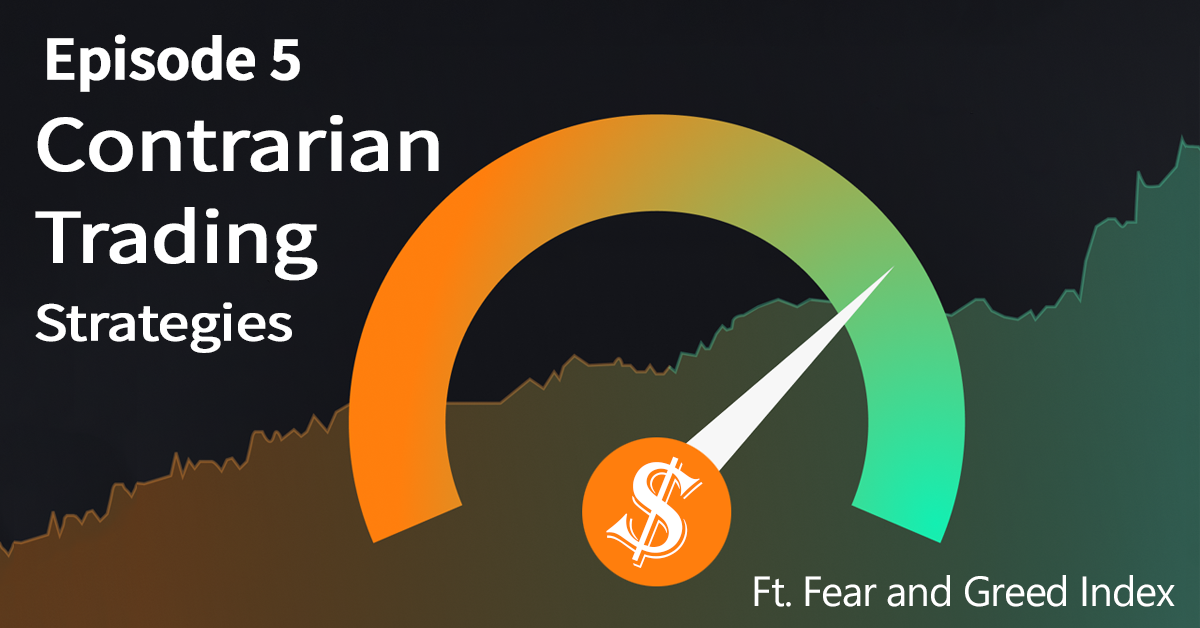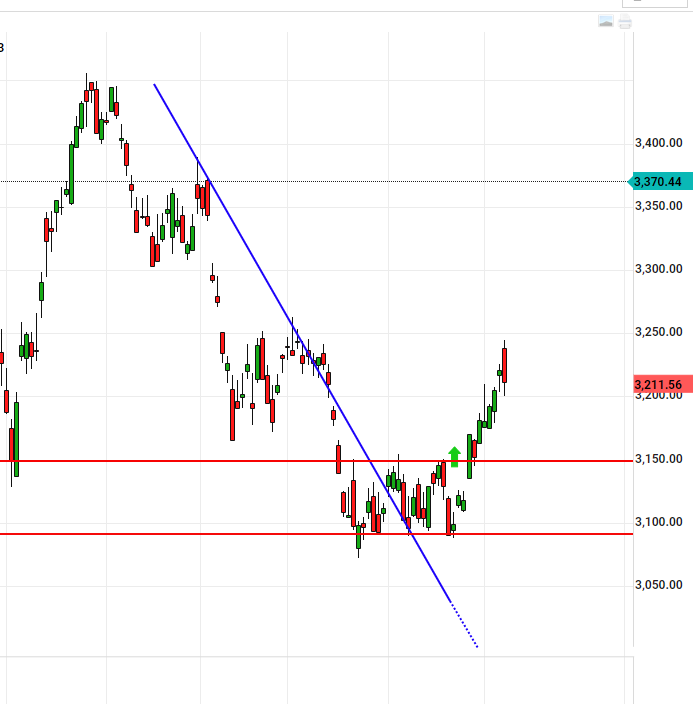Episode 5 – Contrarian Trading Strategies ft Fear and Greed Index August 29, 2022

What is Contrarian Trading?
Contrarian trading might not be familiar to many, but one of the most well-known traders to use this strategy of Contrarian trading is Warren Buffet. “Be fearful when others are greedy, and greedy when others are fearful”, one of Warren Buffet’s most famous quotes sums up what contrarian trading is about. Simply put, you apply this strategy when you go against market trends. Contrarian traders buy when others sell and sell when others buy.
The concept behind: Fear and Greed – Understanding Market Sentiment
The concept behind contrarian trading requires one to understand market sentiment, human psychology and herd behaviour. This is because markets are subject to herd behaviour augmented by fear and greed, which results in markets being periodically over- and under-priced. Herd behaviour occurs when people react to the actions of others and follow their lead. This is similar to the way animals react in groups when they stampede in unison out of danger. Human beings are naturally prone to a herd mentality, conforming to the activities and direction of others in the way they invest. The fear of missing out on a profitable investment idea is often the driving force behind herd instinct, especially in the wake of good news or after an analyst releases a research note with a ‘Buy’ recommendation.
It is due to the natural human instinct of herding that can make those who don’t normally abide by general consensus feel distressed or fearful. If the crowd is generally going in one direction, an individual may feel that he/she is wrong when they go the opposite way, or they may fear being singled out for not jumping on the bandwagon. Based on historical data, herd behaviour has resulted in unfounded market rallies and sell-offs that are often based on a lack of fundamental support to justify either. Herd instinct is a significant driver of asset bubbles, which eventually lead to market crashes in financial markets. One prime example is the dotcom bubble of the early 2000s where this behaviour led to unsubstantiated growth resulting in a bubble that subsequently burst.
A contrarian trader however takes advantage of such market responses. The herd behaviour, which results in the over/undervaluation of stock prices, is seen as an opportunity for the contrarian trader to exploit. A contrarian trader enters the market when others feel negative about it because he/she believes the value of the market or stock is below its intrinsic value and thus represents an opportunity. In essence, an abundance of pessimism among other investors has pushed the price of the stock below what it should be, the contrarian trader will then buy that stock before the broader sentiment returns and the share prices rebound. The opposite is also true. A selling / take profit opportunity is seen in stocks that are currently heavily bought by the market.
Contrarian trading can be rewarding, but at the same time it is also a risky strategy that may take a longer period of time to pay off. Contrarian trading also requires the trader to spend a great deal of time researching stocks to find undervalued opportunities. So, how do well-known investors like Warren Buffet apply this strategy and how is contrarian trading done?
Strategies and Indicators to rely on for Contrarian Trading
By now, you would have guessed that timing plays a very big role in contrarian trading, but how do you identify when to enter and when the market is fearful? Simply betting against market sentiment is one of the fastest and most effective ways to lose money. So, here are 5 steps you can take to formulate a strategy for contrarian trading:
Step 1: Using the daily timeframe, find a stock that has been trending downward for at least three months in a row.
In this example, we will be using the Straits Time Index (STI) as it has been trending down since April 2022 as seen from the graph below.

Contrarian traders prefer a trend that has been running for at least three months as this is a timeframe long enough to start planting fear in other market participants, causing a panic. Panic in the market is actually a contrarian traders’ most favoured market condition. One of the fastest ways to look for these kinds of stocks is to search for stocks that are trading at their 52-week lows.
Another indicator that you can rely on would be the Short Interest Indicator. Short Interest is the total number of shares of a particular stock that have been sold short by investors but not yet covered or closed out. This indicator is great for traders because it allows traders to have a rough gauge on the general market sentiment towards that particular stock, since it shows what short-sellers are doing.
The short interest can be expressed as a number or as a percentage, the latter is derived by dividing the short interest over the number of shares outstanding. For example, when a particular stock’s short interest increases by 10% in one month, this could catch the attention of some traders, as such a significant shift provides a good reason for traders to find out the cause of it. At this point, it might seem natural to avoid stocks with high short-interest because the general market sentiment is poor towards the stock. Why would you want to get involved? However, this is the point where contrarian traders act. Contrarian traders use short interest as a tool to determine the direction of the market because contrarians believe that if everyone is selling, then the stock is already at its low and can only move up. Thus, a high short interest is actually bullish because, eventually, there will be significant upward pressure on the stock’s price when short-sellers have to cover their short positions.
Step 2: Draw a down-trendline and wait for a potential breakout to occur.
Contrarian traders tend to shortlist counters that have been bearish. Therefore, these traders will only construct a down-trendline and be patient until a breakout of the trendline occurs. Do note that in order to constitute a breakout, the price of that candlestick needs to close above the down-trendline. Based on the example above, there was a breakout that occurred on the day indicated by the blue arrow showing that the candle closed above the trend-line.
Step 3: Wait for sideways movement to occur.
A typical trader will enter once the breakout happens in the hope for it to go back up. However, contrarian traders do not enter when everyone else does. They will tend to wait for a sideways movement to occur before entering into a position – essentially, when others are not interested anymore, that is when the contrarian trader will strike. Based on the graph above, the STI was trading sideways for the period indicated between the 2 orange arrows. Contrarian traders draw in an intermediate resistance and support line to make it clearer to them that a sideways/consolidation movement is occurring.
Step 4: Enter when the sideways move breaks upwards.
Once the breakout of the sideways movement occurs, wait for the candle to close above the intermediate resistance line to signify that it is not a false breakout. An indicator that traders can use to help them identify a true or false breakout is by using the Moving Average Convergence Divergence (MACD). MACD is a trend-following momentum indicator that shows the relationship between two moving averages of a security’s price. This indicator can support your analysis when you are trying to spot a “breakout”. A false breakout could be supported by a small MACD histogram – indicating that momentum is low. Upon confirmation of a true breakout, contrarian traders then enter a position based on the opening price of the next day.
As a supporting analysis, traders also rely on the Relative Strength Index (RSI). Developed by J. Welles Wilder, the RSI is a momentum oscillator that measures the speed and change of price movements. The RSI oscillates between zero and 100. Between the ranges of zero to 100, the RSI indicates an “overbought” scenario when it hits 70, and an “oversold” situation when it is below 30. As a Contrarian Trader, you are looking to enter the market when the RSI is below 30 since it signals that the general market sentiments is fearful. The opposite is also true when deciding to open a short position or your take profit point. Contrarian traders tend to short or exit the position when the RSI is above 70, indicating an overbought situation.
The 30-70 bandwidth is, however, not a hard and fast rule. These levels can also be adjusted if it is necessary to better suit that particular stock’s fluctuations. For example, if that particular stock is repeatedly reaching the overbought (oversold) level of 70(30), you may want to adjust this level to 80(20).
Step 5: Setting your stop loss and taking profit.
After opening a position, the next step is to set a take profit point. With a setup as described above, contrarian traders place the stop-loss a few points below the lowest price. In this example, the lowest for the STI was at 3,072, hence traders may choose to put a stop loss at around the 3065 region. As mentioned in the first episode “Traits of a Successful Trader”, a successful trader will have a risk-reward ratio that they will adhere to. Therefore, if the trader has a 1:2 risk to reward ratio then his take profit point will be two times the range from the entry point to the stop loss point.
We hope that this sharing of contrarian trading has provided some insights that can help enhance your trading journey. At PhillipCapital, our online trading platform POEMS houses educational contents such as Market Journals, Podcasts and Webinars with the objective of giving insights to help you make smart investment decisions. Feel free to register and attend the webinars that POEMS has to offer. We also welcome you to approach our Financial Advisory Representatives / Relationship Managers in Phillip Investor Centre who can guide you along your investment journey. Contact ActiveTraders@phillip.com.sg should you have any enquiries or feedback.
Reference:
- [1] https://www.investopedia.com/terms/c/contrarian.asp#:~:text=Key%20Takeaways,markets%20periodically%20over%2D%20and%20underpriced
- [2] https://www.warriortrading.com/contrarian-trading-profit-going-grain/
- [3] https://www.fidelity.com/learning-center/trading-investing/technical-analysis/technical-indicator-guide/rsi
- [4] https://www.investopedia.com/articles/01/082201.asp#:~:text=Short%20interest%20is%20the%20total%20number%20of%20shares,expressed%20as%20a%20number%20or%20as%20a%20percentage
- [5] https://www.investopedia.com/terms/h/herdinstinct.asp
- [6] https://tradingstrategyguides.com/contrarian-trading-strategy/
Disclaimer
These commentaries are intended for general circulation. It does not have regard to the specific investment objectives, financial situation and particular needs of any person who may receive this document. Accordingly, no warranty whatsoever is given and no liability whatsoever is accepted for any loss arising whether directly or indirectly as a result of any person acting based on this information. Opinions expressed in these commentaries are subject to change without notice. Investments are subject to investment risks including the possible loss of the principal amount invested. The value of the units and the income from them may fall as well as rise. Past performance figures as well as any projection or forecast used in these commentaries are not necessarily indicative of future or likely performance. Phillip Securities Pte Ltd (PSPL), its directors, connected persons or employees may from time to time have an interest in the financial instruments mentioned in these commentaries. Investors may wish to seek advice from a financial adviser before investing. In the event that investors choose not to seek advice from a financial adviser, they should consider whether the investment is suitable for them.
The information contained in these commentaries has been obtained from public sources which PSPL has no reason to believe are unreliable and any analysis, forecasts, projections, expectations and opinions (collectively the “Research”) contained in these commentaries are based on such information and are expressions of belief only. PSPL has not verified this information and no representation or warranty, express or implied, is made that such information or Research is accurate, complete or verified or should be relied upon as such. Any such information or Research contained in these commentaries are subject to change, and PSPL shall not have any responsibility to maintain the information or Research made available or to supply any corrections, updates or releases in connection therewith. In no event will PSPL be liable for any special, indirect, incidental or consequential damages which may be incurred from the use of the information or Research made available, even if it has been advised of the possibility of such damages. The companies and their employees mentioned in these commentaries cannot be held liable for any errors, inaccuracies and/or omissions howsoever caused. Any opinion or advice herein is made on a general basis and is subject to change without notice. The information provided in these commentaries may contain optimistic statements regarding future events or future financial performance of countries, markets or companies. You must make your own financial assessment of the relevance, accuracy and adequacy of the information provided in these commentaries.
Views and any strategies described in these commentaries may not be suitable for all investors. Opinions expressed herein may differ from the opinions expressed by other units of PSPL or its connected persons and associates. Any reference to or discussion of investment products or commodities in these commentaries is purely for illustrative purposes only and must not be construed as a recommendation, an offer or solicitation for the subscription, purchase or sale of the investment products or commodities mentioned.
About the author
Alvin Teo and Tan Yan Yi
Alvin Teo graduated from Nanyang Technological University with a Bachelor’s Degree in Economics. Coming from an Economics background, he strongly believes in the importance of understanding macroeconomic policies before making investment decisions. Alvin started investing in Singapore equities at the age of 21 and thus, he has relevant experience in the Singapore market.
Yan Yi graduated from Nanyang Technological University with a Bachelor's Degree in Banking and Finance. As an Equity Specialist, she strongly believes that all investors should make informed investment decisions. Thus she is passionate in educating and guiding clients along their investment journey. Yan Yi also diligently equips herself with market analysis skills and stays updated with economic events.

 Japan’s Economic Resurgence: Unveiling the Tailwinds Behind Nikkei 225’s Record Leap
Japan’s Economic Resurgence: Unveiling the Tailwinds Behind Nikkei 225’s Record Leap  How to soar higher with Positive Carry!
How to soar higher with Positive Carry! ![[Smart Park] Buy Insurance, Get Rich Quick? Not Exactly, But This Comes Close [Smart Park] Buy Insurance, Get Rich Quick? Not Exactly, But This Comes Close](https://www.poems.com.sg/wp-content/uploads/2024/03/Valerie-Lim-LI-X-SMART-Park-Article-300x157.jpg) [Smart Park] Buy Insurance, Get Rich Quick? Not Exactly, But This Comes Close
[Smart Park] Buy Insurance, Get Rich Quick? Not Exactly, But This Comes Close  Deciphering the Updates: Understanding the latest CPF Changes
Deciphering the Updates: Understanding the latest CPF Changes 









